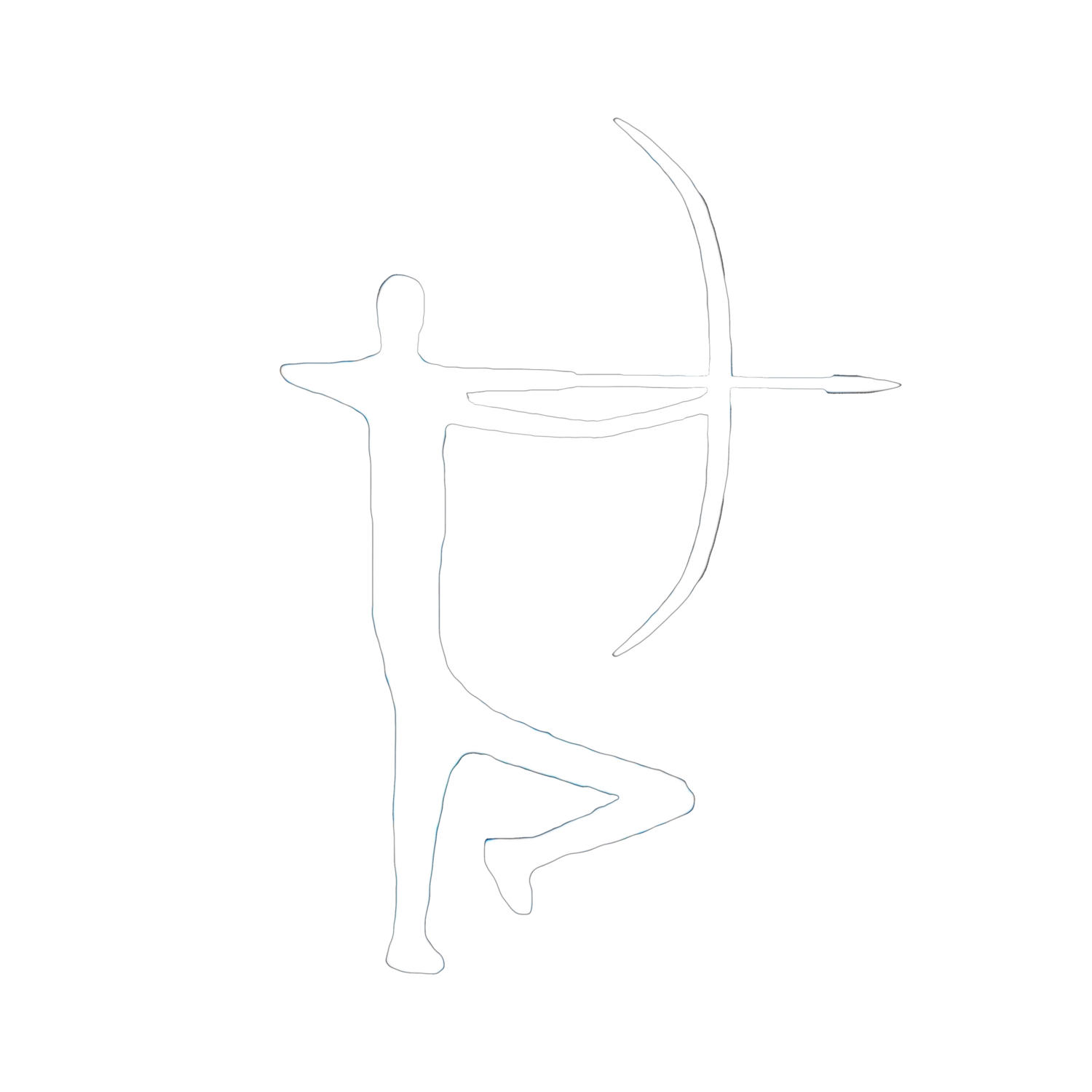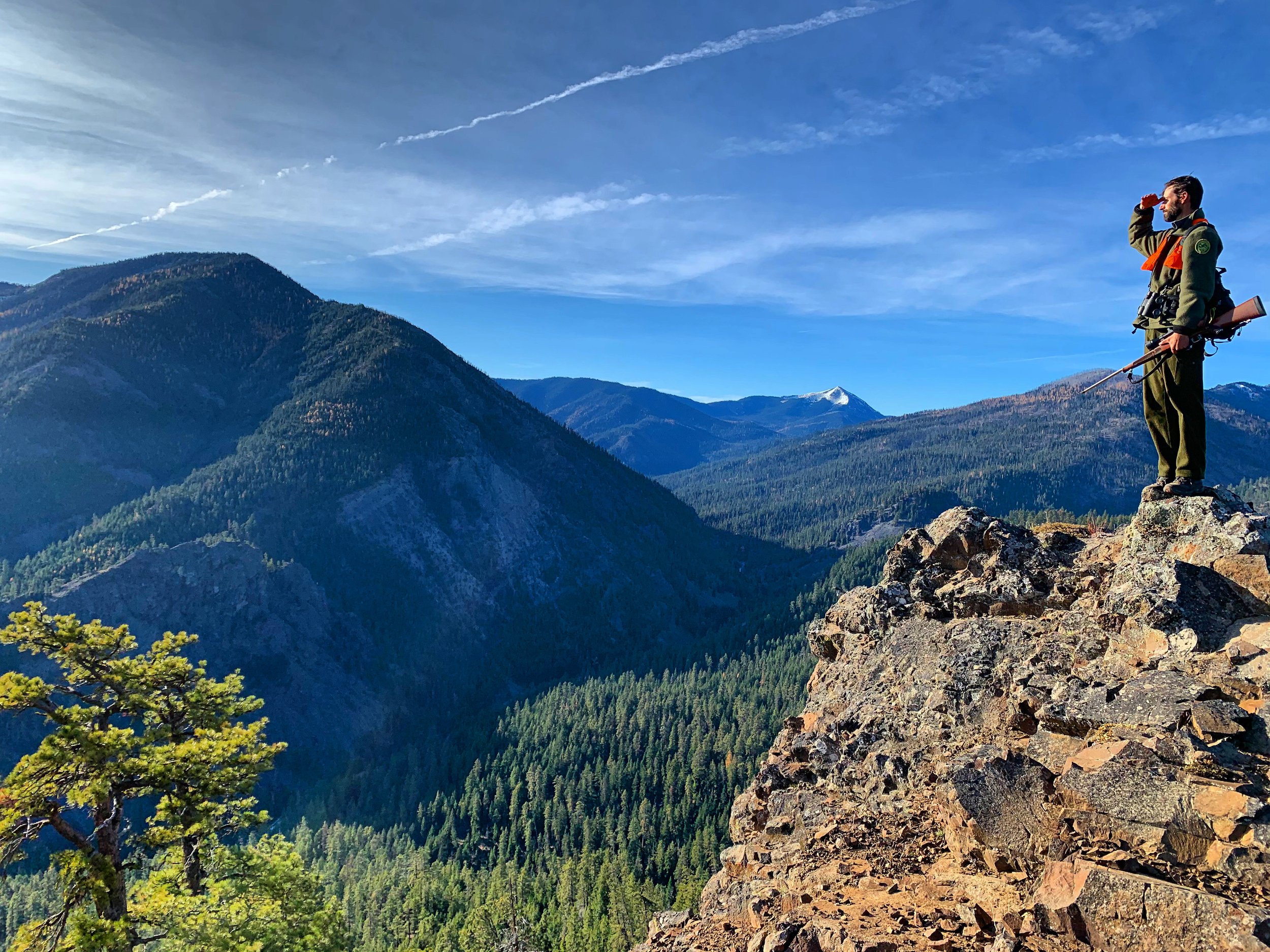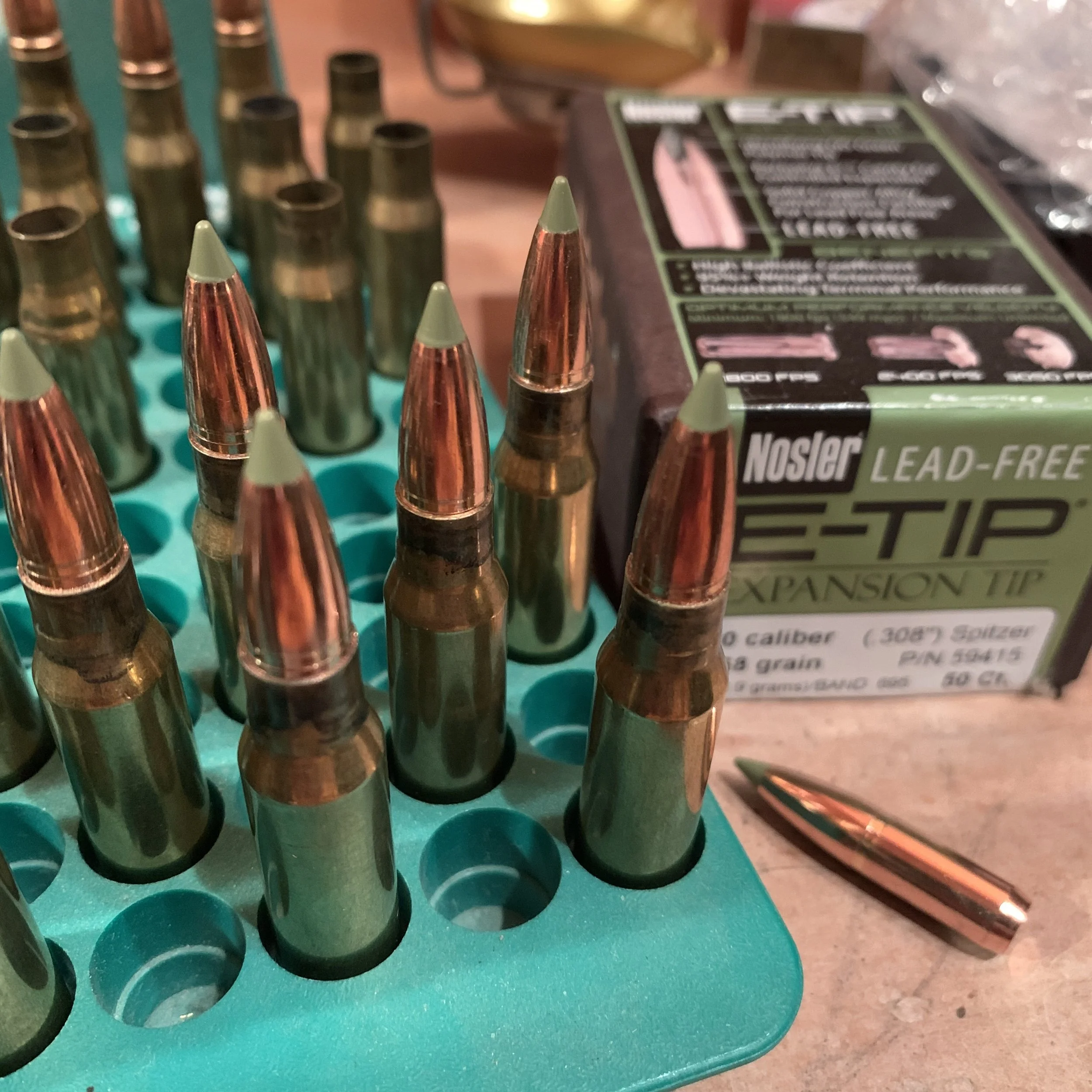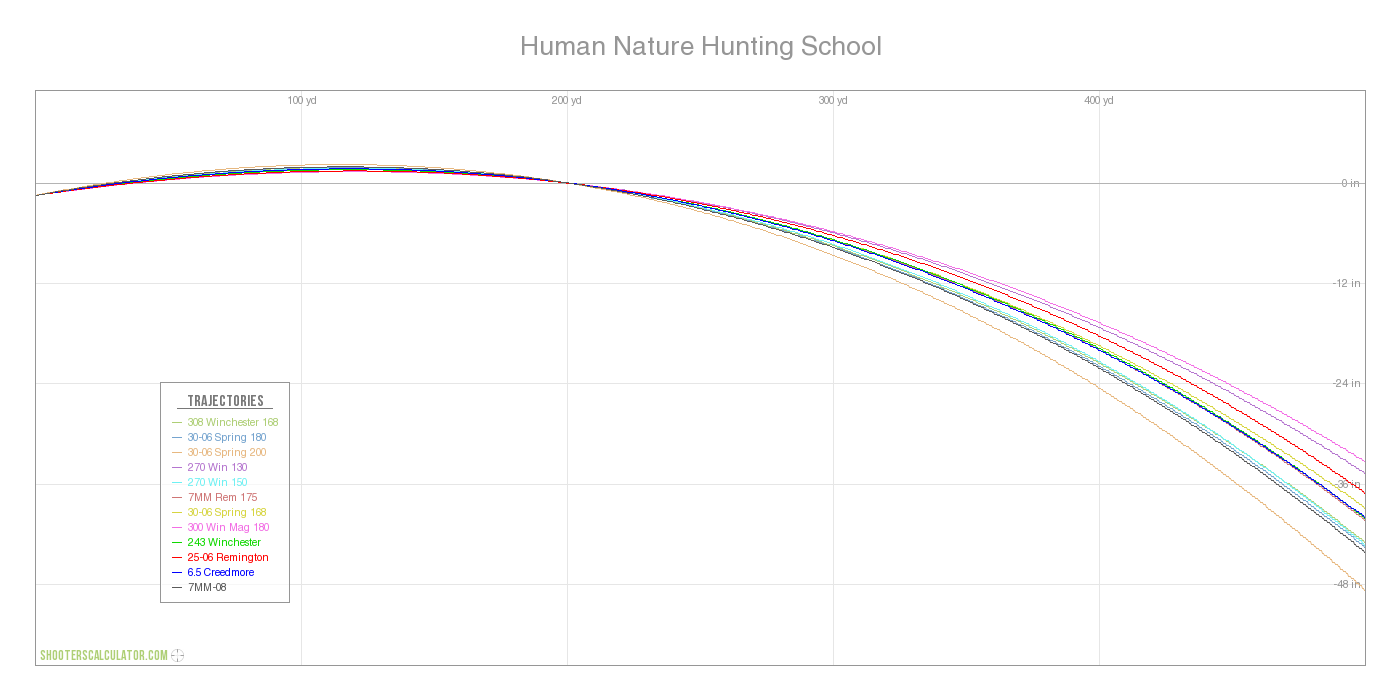How to Choose a Hunting Rifle
How to Choose the Best Hunting Rifle for Your Needs – Part 1 of 3
For deer, elk, black bear, wild boar, antelope, etc.
Bruce McGlenn, Human Nature Hunting School
Having rifle hunted for over a quarter century (mainly for deer and elk) I’ve come to appreciate a few things in the way a rifle works for me. I want it to fit right and be easy and enjoyable to shoot well, I want it to be light enough to carry all day in the field and deliver enough downrange energy for a solid kill. I want it to be reliable and dependable and simple. Personally, I’ve gravitated towards lighter and lighter gear so I can cover the ground without feeling bogged down. I’m a boot hunter and my average shot distance has been decreasing over the years to where most of my shots on deer and elk are under 200 yards; some well under 100. My longest shot in open country near the Continental Divide was just under 400 yards. I’d still take a 300+ yard shot in the right conditions, although I am more inclined to sneak up closer (hence the lighter weight gear). Note, a 3 to 400-yard shot is getting out there (1/4 mile = 440 yards) and without some years of experience or training in long-range shooting the typical hunter will likely opt to get closer. A modest cross wind can push a bullet two feet off course at that range compared to a couple inches at 150 yards.
The author on an elk hunt in Washington
In this three-part series I will cover the topics, below. And in our four-day Awaken the Hunter course we will go into much more detail on these topics, get our hands on different rifles and cartridges and do some shooting in various settings and at different ranges and in different conditions.
Part 1. Cartridge: caliber, ballistics, and ammunition
Part 2. Make/model/fit & feel (action, barrel, stock, trigger, safety, weight)
Part 3. Optics and accessories (scopes, mounts, covers, sling, cheek riser, muzzle brake)
Part 1. Cartridge Selection
Caliber
Often one of the first questions when considering how to choose a hunting rifle, there is no one right answer but there are a lot of options and opinions. I have come to like the 30 caliber (.308 inch diameter) bullet for a combination of its ballistic properties, and weight, which when combined with velocity equates to energy. Energy relates to knock-down power with the right bullet design. A 30-caliber all-copper bullet in the 168-180 grain range has about as good of a ballistic coefficient (think aerodynamics) as you’ll find in these mid-sized calibers (.338 is better but is often more rifle than is needed). This doesn’t matter much until you get out past 2-300 yards. But if you like shooting long distance or want to have the option when needed, a high B.C. will pay off. Also, a 30-caliber bullet offers weights up to 200+ grains, whereas the .270 maxes out at 160 grains (and is really happy shooting 130 grain bullets) and a 6.5 Creedmoor, which has a little less drift in the wind with its more slender design, maxes out at 156 grains (and is happy with 120 grains, which may be about as heavy as it gets with some all-copper bullets – they are longer because the copper is not as dense as lead). A 168+/- grain 30 caliber all-copper bullet might be my new favorite.
Cartridge
Some of the more common deer/elk hunting bolt-action cartridges are .270 WIN | .308 WIN | .30-06 Springfield | 7MM Rem Mag | .300 Win Mag (or 300 Winchester Short Magnum WSM), and more recently the 6.5 Creedmoor or other 6.5MM variations. If you are stout and muscular and plan to take 300-600+ yard shots and like to carry around extra weight, consider a magnum. Maybe. If you want a lighter weight and lighter recoil rifle and plan to keep your shots under 300 yards for the most part, consider the .270, .308, .30-06, 7MM-08, or the 6.5 CRDMR. It’s often been said that the ol’ .30-06 is as close to an all-around rifle as one can find. The extra powder capacity over the .308 gives it a slight advantage. But not much. The .308 seems to be a more efficient round and by handloading, one can achieve impressive velocities. In many ways, the .308 has taken the place of the .30-06 as the all-around do-everything cartridge (especially when hand-loading with modern powders and bullets). And the shorter cartridge allows for a short action.
Recoil
Recoil from a .308 Winchester Model 70 Featherweight in the hands of a new shooter. No muzzle brake. Notice the bill of the hat being knocked a bit by the scope.
Every action has an opposite and equal reaction. And there are ways of mitigating the kick. Even seasoned shooters need to have a strong mental game with shooting, and less recoil means less flinching and fewer bad shots. All things being equal, a heavier rifle will have less kick. So, an ultralight rifle can amplify the felt recoil. A modern recoil pad helps. A muzzle brake reduces recoil by allowing gasses to escape to the side, but it makes the bang much louder, especially if you are sitting off to the side. And a suppressor helps with both noise and recoil, but it adds weight and bulk to a sleek hunting rifle and can take some time to order and install if you don’t already have a threaded barrel. Chuck Hawks provides this recoil table for comparison. In the end, bullet placement kills. If a magnum rifle causes flinching and therefore failure to hit the mark, it doesn’t matter how much energy you have. A lighter cartridge shot with confidence and consistency will outperform. And if you think you are immune to flinching as a new shooter, think again.
Ballistics - Energy
As a general rule of thumb, it’s good to have at least 1500 ft-lbs to kill an elk and 1000 ft-lbs to kill a deer.
I mentioned the ballistic coefficient earlier. The higher the number (more aerodynamic) the more it retains its velocity down range. Since energy is a function of mass and velocity squared, speed counts. And there is a sweet spot; going too light and fast with a bullet will cause problems (bullet fragmenting on impact and not retaining mass to punch through heavy hide and bone). With the ballistic coefficient, bullet weight, and muzzle velocity you can easily calculate the ballistic charts for any cartridge. There are a number of online calculators; I like this one as it allows me to enter several cartridges at once to compare and I can create a link to that comparison. Here is one with several of the cartridges I mentioned earlier. You’ll notice with smaller B.C. bullets the velocity and hence the energy will drop off faster. Sectional density is the ratio of the bullet’s mass to it cross-sectional area. A short, stubby bullet will have a lower SD. But the construction of the bullet is a more important factor.
http://www.shooterscalculator.com/ballistic-trajectory-chart.php?t=d73b3c64
Sectional density, ballistic coefficient, overall length of Nosler E-tip all-copper bullets
Ballistics – Trajectory
You’ll also notice from looking at the calculated ballistics charts that there isn’t a huge difference in bullet drop for most of the common cartridges at reasonable ranges. All bullets drop, some faster than others. Again, if most of your shots will be under 300 yards, drop for most hunting cartridges will be between 6 and 8 inches. If you are shooting 600 yards, the differences amplify. But if you know your ballistics and you know your range and cross wind, it’s just a matter of compensating. For starters I would suggest considering keeping your shots to 300 yards or less. 200 is better. 100 better yet. When you get out in the field with a case of buck fever you will understand why…
Trajectory of common hunting rounds out to 500 yards
Ammunition & Bullets
Some rounds are more available and less expensive than others. Because of the popularity of the .308 or .30-06 there are usually more abundant ammo choices and therefore inexpensive options for target practice compared to say the 6.5 Creedmore. In 2022, a quick search results in the cheapest .308 ammo for just under $.60/round, whereas the cheapest 6.5 is $1.10 (almost double). And some of the 300 Magnum rounds use nearly twice the powder as the .308 so expect to pay more ($1.60/round minimum for 300 Win Mag). A good resource for checking on the price and availability of a particular round is www.ammoseek.com. Search for .308 and 6.5 Creedmore and notice the cheapest options for each.
I mentioned “knock-down power” earlier. A good hunting bullet is designed to expand upon impact with hide and muscle and bone (mushroom out) without fragmenting. In contrast an armor-piercing bullet with the same energy behind it will do less damage since it doesn’t expand and dump most of its energy into the target, rather goes right through and keeps on going.
All-copper bullets are designed to hold together better than lead-core bullets that can fragment upon impact. However, the stronger (copper) bullet design likes a little more velocity in order to achieve ideal expansion. Therefore, where I once opted for the copper jacketed lead 180 grain 30 caliber bullet for elk, I prefer a 168 grain all copper bullet that moves a little faster. I’m even experimenting with 150 grain options. Because it is less likely to fragment, the smaller copper bullet usually retains more weight than the larger lead core bullet in the long run. So, I feel I can get away with a lighter, faster bullet and achieve similar results. Plus, lighter/faster shoots flatter.
A side note on reloading: I’ve been doing it for about 15 years and have moved to the all-copper bullets that Barnes has been manufacturing now for a while and other companies like Nosler has followed suit. Examples: http://www.barnesbullets.com/bullets/lrx/ and https://www.nosler.com/e-tip-lead-free-bullet. Loading data with velocities for associated bullet weights can be found here: https://load-data.nosler.com/.
All-copper Nosler E-tip bullet recovered from elk (left) and a copper-jacketed lead-core bullet (right)
Conclusion
Choosing your first hunting rifle can be overwhelming as a new hunter but once you understand the variables it helps to narrow the choices. These recommendations are based on my opinions and experience hunting big game since the late 1980’s. There are many approaches to hunting. I prefer to keep it simple and focus on the hunt more than the gear. I prefer to keep it light and cover the ground. I prefer to pack into the backcountry and hunt for several days if I have the time. Or day hunts often involve several miles of hiking. In any case, the more time spent learning the terrain and habits of the animals and getting up close the better in my opinion. Again, emphasize opinion.
My first rifle I bought in my early teens with saved up paper-route money was a Remington Model 700 Mountain Rifle chambered in .270. I still have it and I still enjoy shooting and hunting with it, though I felt the recoil was a little much for my younger self. Later I inherited my dad’s 7MM Remington Magnum (when he bought a new .270 WSM), a great rifle that helped me bring home dozens of animals for the freezer, but ultimately, I got tired of carrying the extra weight around the mountains.
Currently I hunt deer and elk with a .308 Winchester using handloads with 168 grain E-tip Nosler bullets and muzzle velocity of just under 2800 ft/sec. (I can’t find factory ammo with quite this much energy.) The last mature bull elk I shot at 250 yards ran about 50 yards and tipped over. The all-copper bullet entered the ribs, broke the large shoulder bone on the far side and the bullet came to rest just under the hide. Here is a photo of the recovered bullet and a live round with which I hunt. The above photo is a close up of this bullet.
In the following posts I’ll share some thoughts and ideas about what characteristics and features to consider when purchasing your first hunting rifle. Feel free to ask questions in the comment section, below.
References:
Reloading data: https://load-data.nosler.com/load-data/308-winchester/
Recoil Table: https://www.chuckhawks.com/recoil_table.htm
Ballistics Calculator: https://shooterscalculator.com/ballistic-trajectory-chart.php
Ballistics charts for common hunting rounds: http://www.shooterscalculator.com/ballistic-trajectory-chart.php?t=d73b3c64
Online ammunition search: https://ammoseek.com/
6.5 Creedmoor | https://en.wikipedia.org/wiki/6.5mm_Creedmoor
.270 Winchester | https://en.wikipedia.org/wiki/.270_Winchester
.308 Winchester | https://en.wikipedia.org/wiki/.308_Winchester
.30-06 Springfield | https://en.wikipedia.org/wiki/.30-06_Springfield
7MM Remington Magnum | https://en.wikipedia.org/wiki/7mm_Remington_Magnum
.300 Winchester Magnum | https://en.wikipedia.org/wiki/.300_Winchester_Magnum
.300 WSM | https://en.wikipedia.org/wiki/.300_Winchester_Short_Magnum






